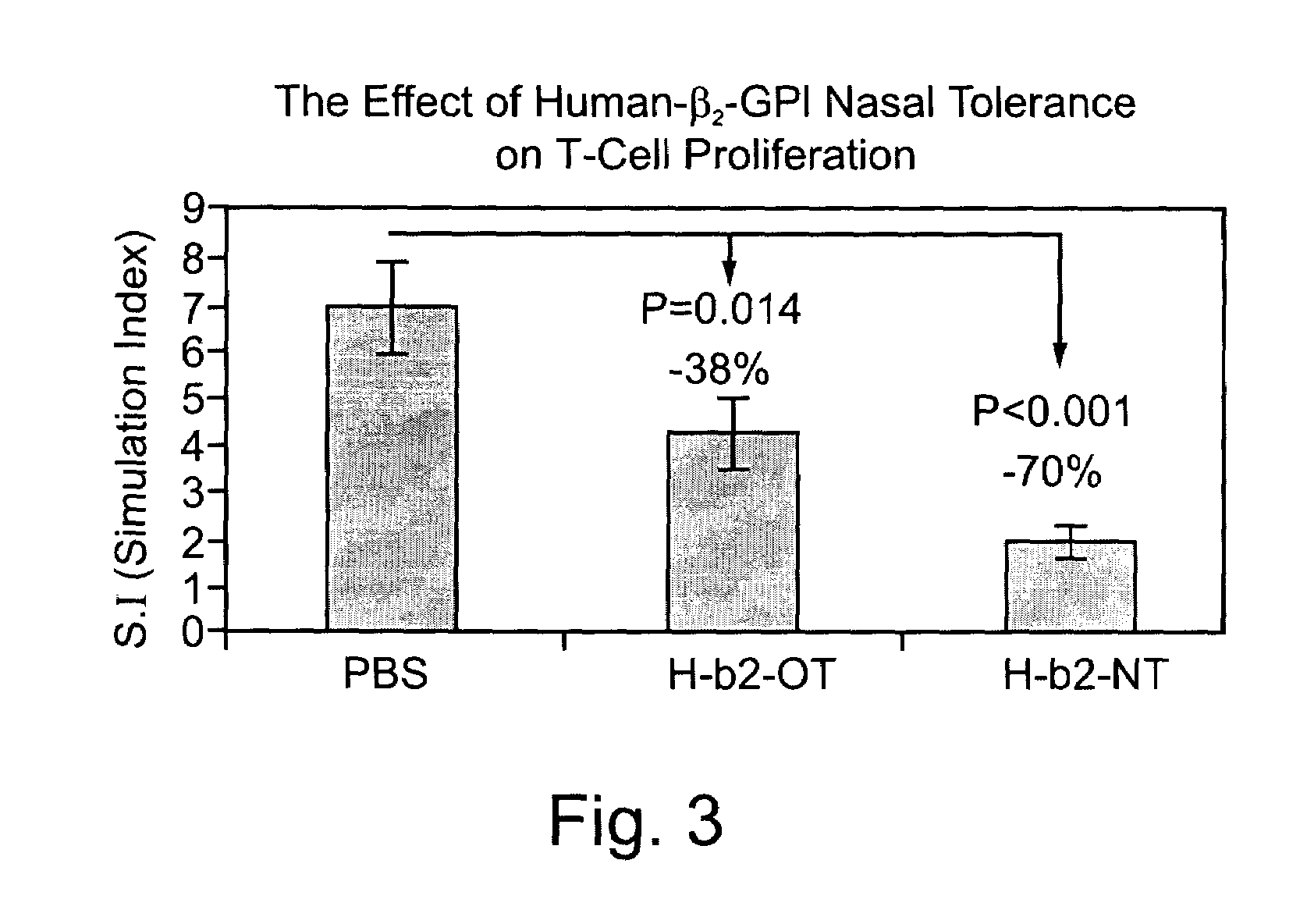Methods employing and compositions containing plaque associated molecules for prevention and treatment of atherosclerosis
a plaque-associated molecule and composition technology, applied in the direction of antibody medical ingredients, peptide sources, metabolism disorders, etc., can solve the problems of severe pain, lack of oxygen supply in tissues, and major health risks of cardiovascular diseases, and achieve the effect of inhibiting atheroslerosis and other plaque-related diseases and superior immune toleran
- Summary
- Abstract
- Description
- Claims
- Application Information
AI Technical Summary
Benefits of technology
Problems solved by technology
Method used
Image
Examples
example 1
Inhibition of Atherogenesis in Genetically Predisposed (Apo-E-Deficient) Mice by Induction of Nasal Tolerance with Low Doses of the Plaque Associated Molecules Oxidized LDL, Human Beta2GPI and HSP 65
[0128]The present inventors here demonstrate, for the first time, that nasal exposure to low doses of the plaque associated molecules oxidized LDL, Beta2GPI and HSP 65 provides induction of tolerance to the antigens, and significant inhibition of atherogenesis. Thus, nasal exposure to purified, oxidized human LDL, human Beta2GPI and recombinant mycobacterial HSP 65 were compared for their effectiveness in suppressing atherogenesis in Apo-E-deficient mice. 63 male 9-13 week old Apo E / C 57 mice were divided into 5 groups. In group A (HSP-65)(n=12) nasal tolerance was induced as described in Materials and Methods by administration of recombinant mycobacterial HSP 65 suspended in PBS (10 μg / mouse / 10μl) for 5 days every other day. In group B (H-oxLDL)(n=14) nasal tolerance was induced as desc...
example 2
Superior Inhibition of Atherogenesis in Genetically Predisposed (Apo-E-Deficient) Mice by Induction of Nasal Tolerance with HSP 65
[0131]The present inventors here demonstrate, for the first time, that nasal exposure to exceedingly low doses of the plaque associated molecule HSP 65 provides superior induction of tolerance to the antigen, and inhibition of atherogenesis. Thus, nasal exposure to a low dose and an exceedingly low dose of recombinant human HSP 65 were compared for their effectiveness in suppressing atherogenesis in Apo-E-deficient mice. 58 male 12-16 week old Apo E / C 57 mice were divided into 4 groups. In group A (HSP-65 high)(n=14) nasal tolerance was induced as described in Materials and Methods by intranasal administration of 10 g / mouse / 10 μl recombinant human HSP 65 suspended in PBS for 5 days every other day. In group B (HSP-65 low)(n=16) nasal tolerance was induced as described in Materials and Methods by administration of 1 μg / mouse / 10 μl recombinant human HSP 65 ...
example 3
Superior Suppression of Specific Anti-Beta2GPI Immune Reactivity in Genetically Predisposed (apo-E Deficient) Mice by Intranasal Administration of Human Beta2GPI
[0134]Tolerance induced by mucosal exposure to plaque associated molecules may be mediated by suppression of specific immune responses to antigenic portions of these plaque associated molecules. Lymphocyte proliferation in response to mucosal (nasal and oral) exposure to human Beta2GPI was measured in Apo-E-deficient mice. 9 male, 5 week old Apo E / C 57 deficient mice were divided into 3 groups. In group A (n=3) oral tolerance was induced with 100 μg / mouse Beta2GPI suspended in 0.2 ml PBS, administered by gavage, as described above, every other day for 5 days. In group B (n=3) nasal tolerance was induced with 10 μg / mouse Beta2GPI suspended in 10 μl PBS, administered intranasally as described above, every other day for 5 days. The mice in group C (n=3) received oral administration of 200 μl PBS every other day for 5 days. Immu...
PUM
| Property | Measurement | Unit |
|---|---|---|
| volume | aaaaa | aaaaa |
| particle size | aaaaa | aaaaa |
| particle size | aaaaa | aaaaa |
Abstract
Description
Claims
Application Information
 Login to View More
Login to View More - R&D
- Intellectual Property
- Life Sciences
- Materials
- Tech Scout
- Unparalleled Data Quality
- Higher Quality Content
- 60% Fewer Hallucinations
Browse by: Latest US Patents, China's latest patents, Technical Efficacy Thesaurus, Application Domain, Technology Topic, Popular Technical Reports.
© 2025 PatSnap. All rights reserved.Legal|Privacy policy|Modern Slavery Act Transparency Statement|Sitemap|About US| Contact US: help@patsnap.com


